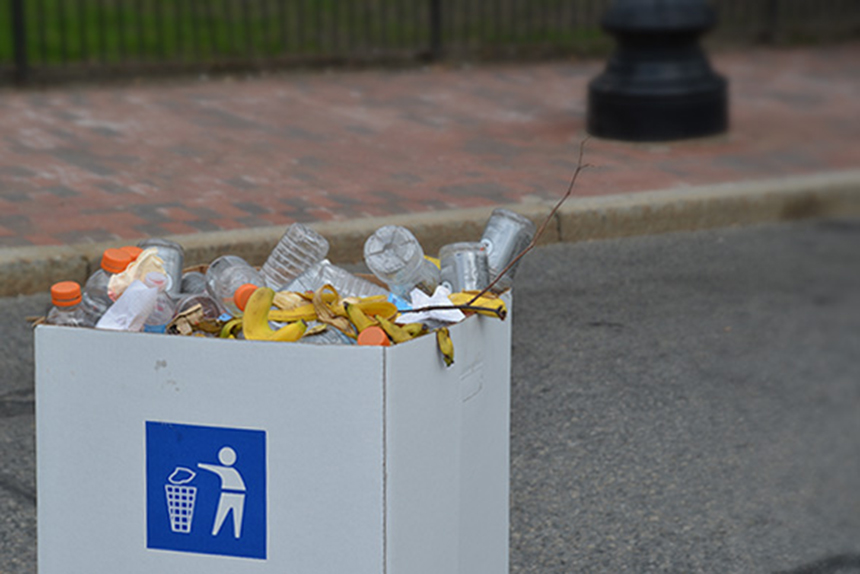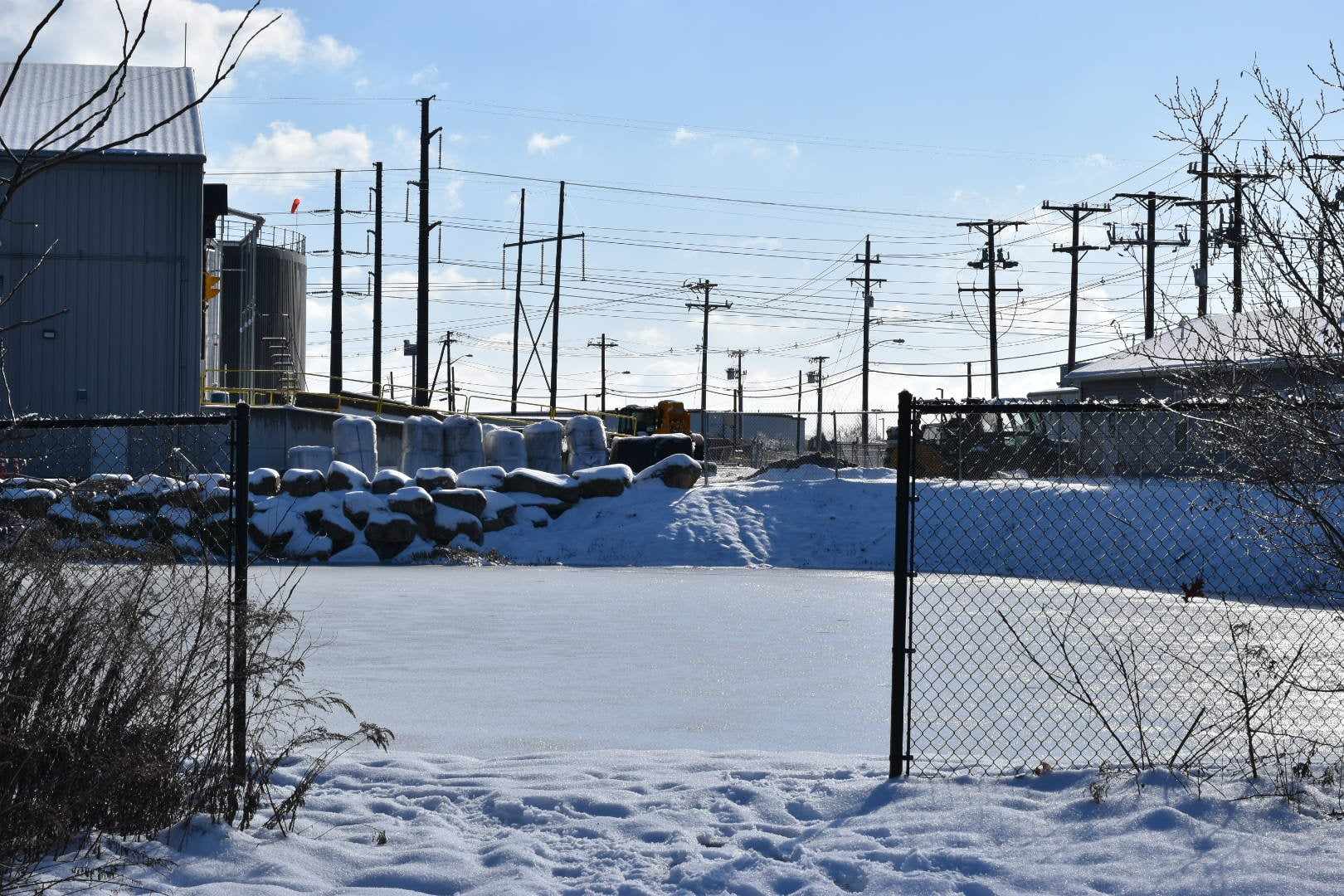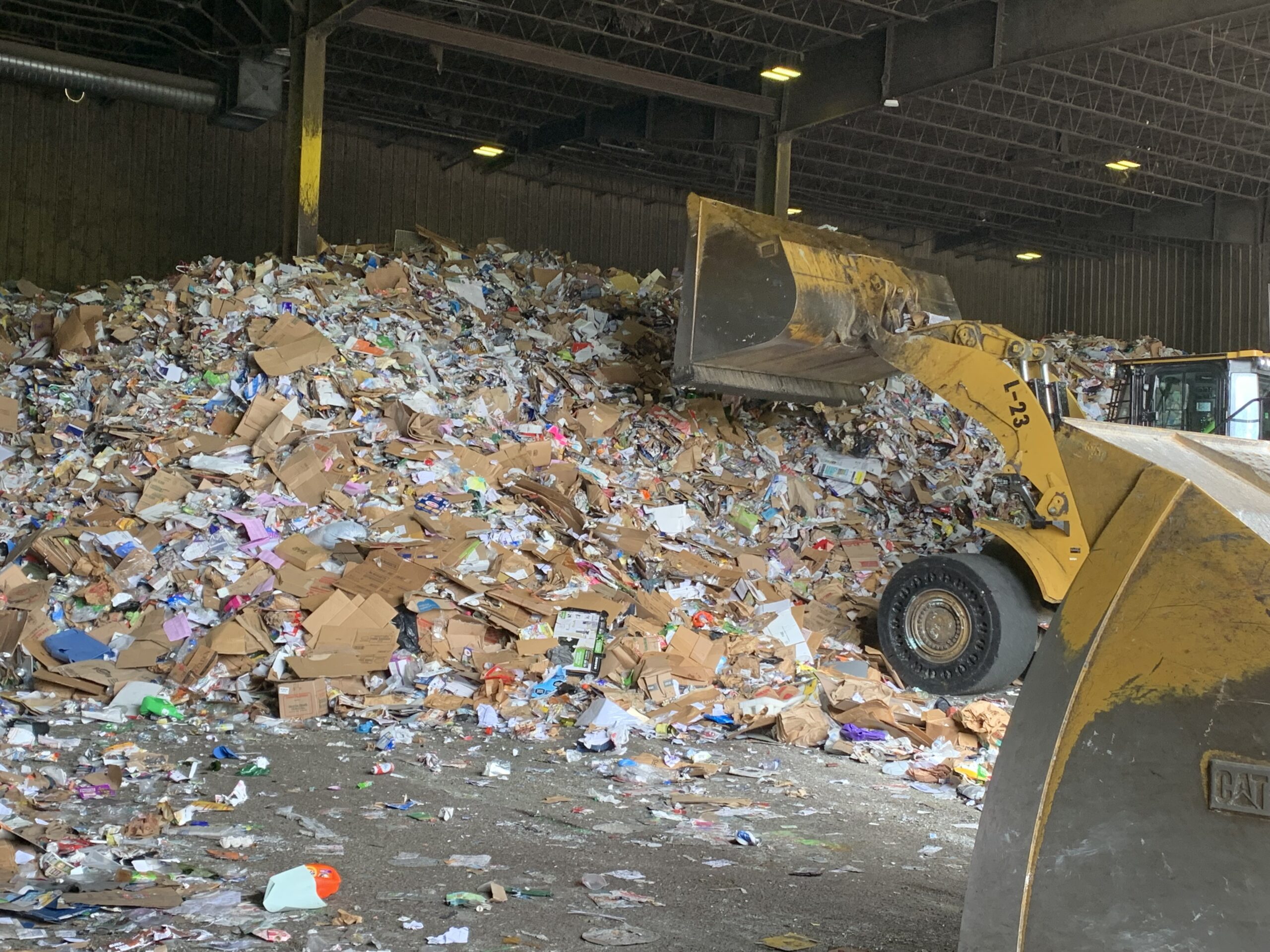Central Landfill Investigation Uncovers Waste
Recent study determines state still struggling to divert recyclables and compostables from the waste stream
April 27, 2016
JOHNSTON, R.I. — Cardboard and compostables are two of the most common categories of waste filling up Rhode Island’s Central Landfill, according to a recently published study by the Rhode Island Resource Recovery Corporation (RIRRC). The study aimed to identify materials that could be diverted from the landfill, presently or in the future, to recycling facilities or for reuse.
The yearlong study, which began in November 2014, was the first of its kind conducted in Rhode Island since 1990, according to Sarah Reeves, director of public policy, programs and planning at RIRRC, who provided a briefing on the report April 14 at the Statehouse. The study focused on residential, commercial and bulky waste, which accounted for 583,000 tons of waste added to the landfill in 2015 — 56 percent of the total landfill-bound waste stream.
Over the course of the study, 248 loads of trash were hand sorted into 70 categories, including 12 plastic categories, 17 paper and cardboard categories, six metal categories, and numerous categories of glass, hybrids containers, textiles, organics, and medical and hazardous waste. Bulky waste — items that don’t fit in a bag or garbage can, such as furniture — was inspected visually.
Drivers were surveyed to determine where their loads originated, allowing RIRRC to further refine its findings by comparing commercial waste from different generators, such as grocery stores and office buildings.
Residential findings
Residential waste delivered to the landfill in 2015 weighed 303,000 tons — 29 percent of the total landfilled waste. The study found that about one-third of residential waste is comprised of compostable material such as food scrap, leaf and yard debris, and compostable paper. Another 4 percent is larger compostable items such as branches that would require chipping prior to being composted.
Fourteen percent of the residential waste delivered to the landfill could have gone to RIRRC’s recycling facility instead, such as cardboard, paper and recyclable containers. According to Reeves, Rhode Island compares favorably to other states in this category. In terms of paper diversion specifically, she said Rhode Island’s residents outperform those of Connecticut and Vermont, each of which conducted similar studies within the past six years.
Textiles, including apparel, bed sheets, towels and curtains, comprised 7 percent of landfilled residential waste in 2015. Textiles can be diverted via drop-off programs such as donation boxes or programs offered by organizations such as Goodwill, Savers or the Salvation Army. Textiles don’t have to be in good condition to be donated, because items unfit for reuse are recycled into rags and other products.
Even if all possible residential waste was diverted to recycling centers, compost operations, anaerobic digesters or drop-off recycling locations, such as textile or book donation boxes or plastic bag recycling bins at grocery stores, 34 percent of this waste would still end up in the landfill.
“We are always going to need some form of disposal,” Reeves said. “We will never have 100 percent no landfill. There will always be some need for the landfill or, in some states, an incinerator.”
Commercial findings
Commercial waste sent to the landfill last year weighed 225,000 tons — 21 percent of the total waste sent to the landfill. Compared to residents, “industrial, commercial, and institutional generators do not appear to be doing as effective a job at diverting potential recyclables,” according to the recent report.
Twenty-seven percent of the commercial waste sent to the landfill could have been recycled at a standard recycling facility. Corrugated cardboard and brown paper, for example, comprised 14 percent of commercial waste sent to the Central Landfill.
Despite Rhode Island law requiring businesses to recycle, Reeves said there are impediments that stop businesses from doing so. Sending recyclables to a recycling facility can cost more than dumping them in the landfill, she said, so many businesses do the latter. Due to lax enforcement, these businesses pay no penalty for their bad behavior. Meanwhile, businesses that follow the law at an additional cost are put at a competitive disadvantage.
Finding space to add another Dumpster for recyclables can also be a challenge in some locations, Reeves noted.
She said business owners who don’t currently recycle should work with their waste haulers to incorporate recycling into their next contract. RIRRC has a staff person specifically designated to helping businesses conduct waste audits and set up recycling programs. In some cases, by reducing waste and recycling, businesses can break even, according to Reeves.
Compostable waste such as food scrap and compostable paper comprised 23 percent of commercial waste sent to the landfill last year.
As with residential waste, one-third of all commercial waste currently being delivered to the landfill can’t be diverted via any recycling method, further emphasizing Reeve’s point that the state isn’t on the verge of a zero-waste future.
Sector-specific solutions
While residential waste is relatively homogeneous across municipalities, commercial waste varies depending on its sector of origin, according to the report. This means sector-specific recycling solutions will be more effective than a one-size-fits-all approach, Reeves said.
Grocery stores and restaurants, for example, generate massive amounts of food scrap — 46 percent and 48 percent, respectively, of their total landfill-bound waste. Furthermore, 8 percent of landfill-bound waste generated at grocery stores and 11 percent at restaurants is compostable paper, and 20 percent of landfill-bound waste generated by grocery stores is corrugated cardboard.
Meanwhile, large retailers and offices generated higher amounts of paper and cardboard — 29 percent of landfilled waste generated by large retailers, for example, was corrugated cardboard. These sectors also generated a high percentage of organics, mostly comprised of food scrap. One-quarter of the waste sent to the Central Landfill by large retailers and 44 percent from offices were organics that could be diverted to a composting facility or anaerobic digester.
“With some generators being large food waste generators, some large generators of paper, and some not generating significant quantities of divertible material, any program to increase commercial diversion will require targeted education and promotion,” according to the report.
Bulky waste
Some 55,000 tons of waste delivered to the landfill in 2015 was classified as bulky waste — 5 percent of the total waste landfilled. Of that, only one-third could have been diverted from the landfill, according to the report. The majority of bulky waste is trash, Reeves said.
Twenty-two percent of the bulky waste delivered to the landfill was furniture, almost all of which was considered trash by RIRRC. “While it is potentially possible to recover bulky furniture items from bulky waste, much of it is beyond recovery, and at least some were rejected materials from reuse stores,” according to the report.
Reeves noted that bulky waste costs municipalities additional money that could be saved if the amount of waste was reduced.
Next steps
Increasing recycling of corrugated cardboard in the commercial waste stream and organics from the commercial and residential waste streams should be the focus of diversion efforts, according to the report. Concerning organics recycling, Reeves recommended focusing on the commercial waste stream first, as food-scrap collection on the residential level can be inefficient and costly.
Even assuming a perfect recycling rate, only 35 percent of the 1 million tons of waste currently entering the landfill annually can be diverted, according to the report. Since most waste isn’t divertible, Rhode Island must develop a future disposal method to replace the landfill, which will reach capacity in 22 to 30 years, Reeves said.
RIRRC will vet a variety of disposal options, including a new landfill, composting and anaerobic digestion, sending waste out of state, mixed-waste processing and incineration, prior to the 2019 update of its Solid Waste Management Plan to help determine the best option(s), Reeves said.
Reeves noted that citing a large-scale digester or incinerator can be a seven- to 10-year process, so must be considered far in advance of the current landfill’s closure.
Concerning incinerators, Reeves said, “We are bounded by the most number of waste-to-energy facilities in the country in Massachusetts and Connecticut, so (they’re) here, but should (they) be in Rhode Island?”
While not the focus of the report, contamination of recyclables being delivered to RIRRC’s recycling facility remains an issue, Reeves said. Twelve percent of the waste delivered to the recycling facility, or some 14,000 tons, isn’t recyclable and is moved to the landfill. An additional 10,400 tons of mostly recyclable loads of waste are rejected because of contamination and delivered to the landfill instead of the recycling facility, according to Reeves.
Loads are rejected when they contain medical waste such as sharps or dialysis bags, or if they contain diapers that have opened, paint or oils that have coated the recyclables, or food scrap. Leftover food, takeout containers with food in them, and soup were described as especially problematic. Reeves said residual peanut butter inside a container isn’t the problem; instead, it’s when half eaten meals are littered throughout a load that recyclables are rejected.




In the condo I lived in Providence, I used to routinely see the RI contracted garbage company (private company) put separated recyclables into the same bulk truck as the trash (all dumped in the same place). I complained to condo association who complained to private contractor … but after a few weeks they went back to the same behavior.